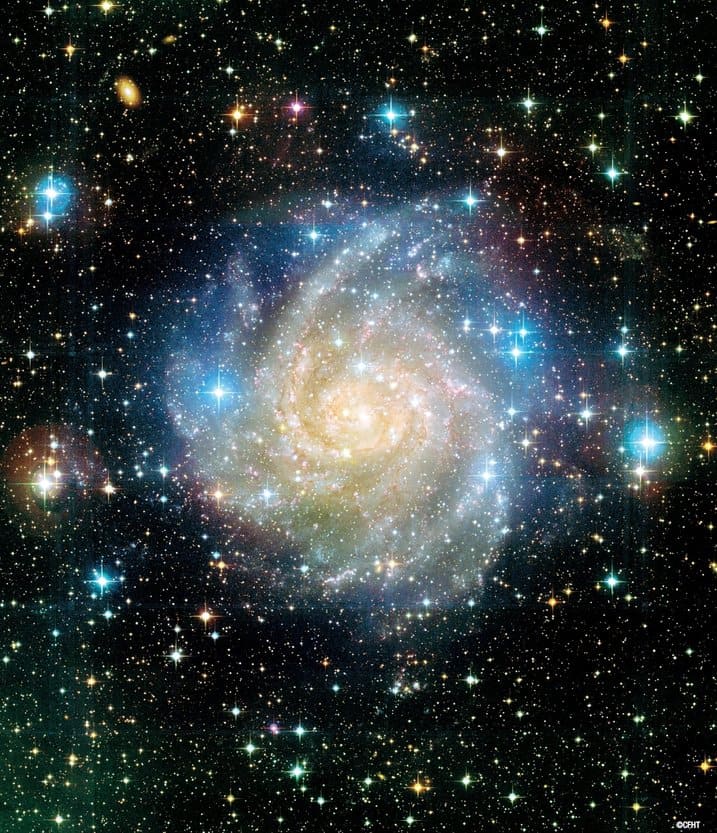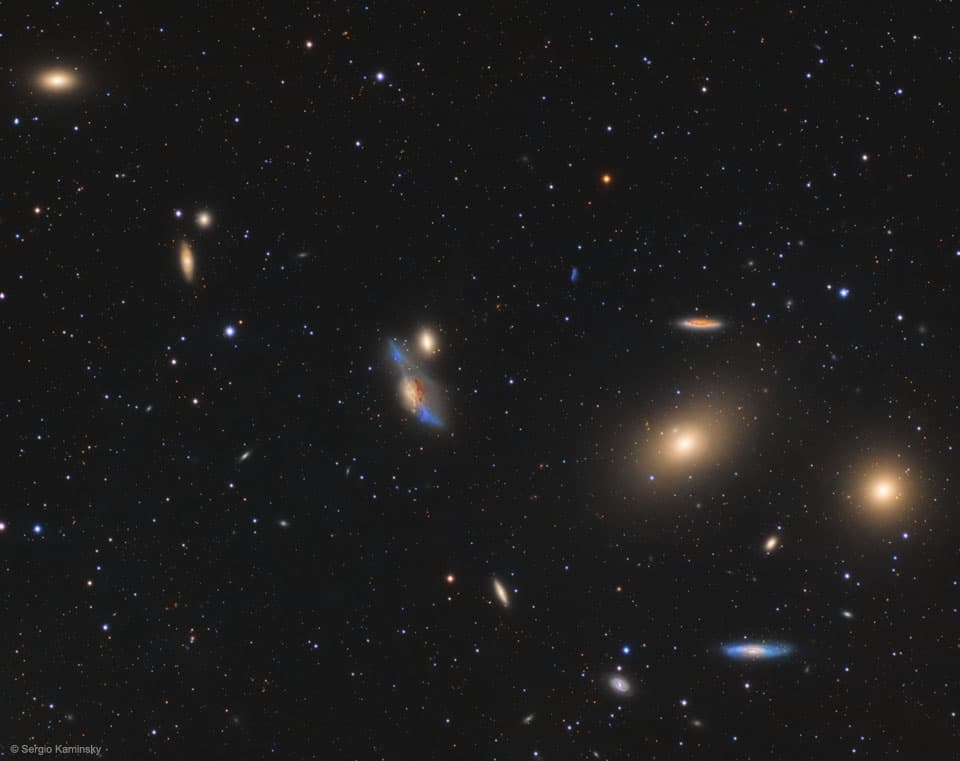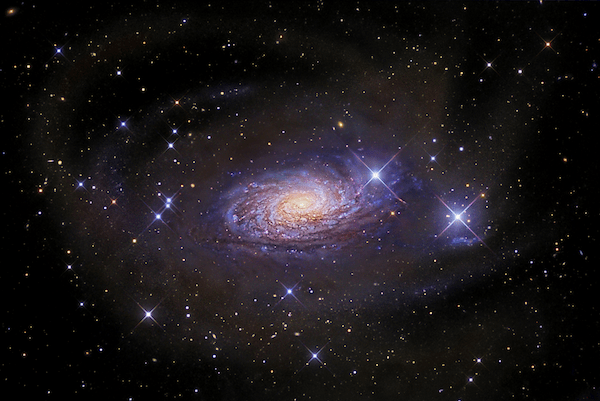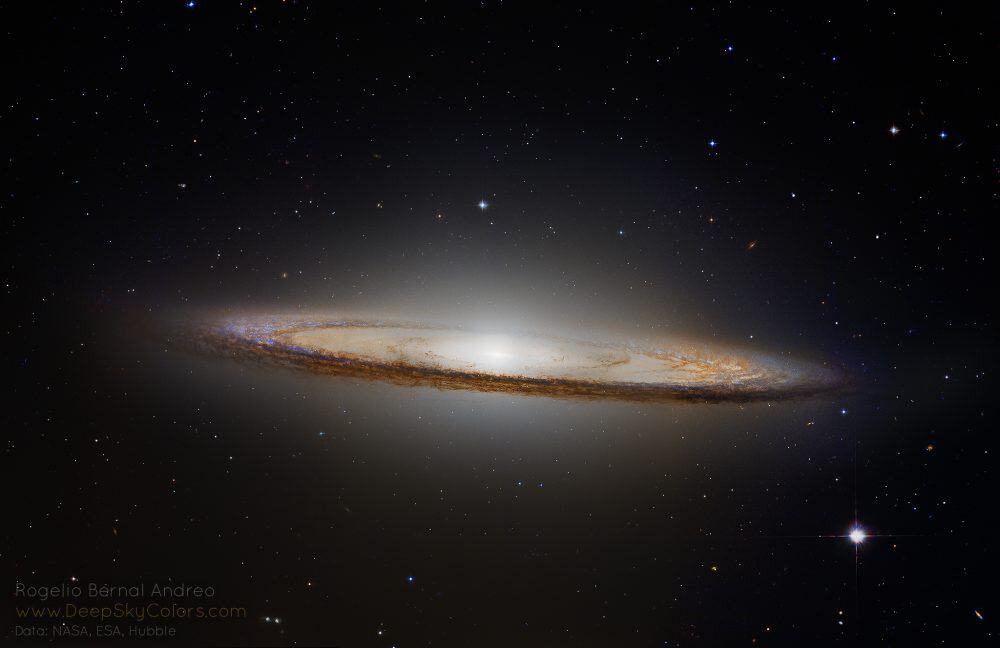Blog
At 11 million light-years away, IC 342 is a close galaxy. It’s also a member of a loose group along with several others. IC 342 has a low surface brightness and lies in Camelopardalis, near the plane of the Milky Way in our sky. So it’s a little difficult for amateur astronomers to spot, despite its elegant form.
more...
Gilbert Scott-Heron (April 1, 1949 – May 27, 2011) was an American soul and jazz poet, musician, and author, known primarily for his work as a spoken-word performer in the 1970s and 1980s. His collaborative efforts with musician Brian Jackson featured a musical fusion of jazz, blues, and soul, as well as lyrical content concerning social and political issues of the time, delivered in both rapping and melismatic vocal styles by Scott-Heron. His own term for himself was “bluesologist”, which he defined as “a scientist who is concerned with the origin of the blues”.
His music, most notably on the albums Pieces of a Man and Winter in America in the early 1970s, influenced and foreshadowed later African-American music genres such as hip hop and neo soul. Scott-Heron is considered by many to be the first rapper/MC ever. His recording work received much critical acclaim, especially one of his best-known compositions, “The Revolution Will Not Be Televised“. AllMusic‘s John Bush called him “one of the most important progenitors of rap music,” stating that “his aggressive, no-nonsense street poetry inspired a legion of intelligent rappers while his engaging songwriting skills placed him square in the R&B charts later in his career.”
Scott-Heron remained active until his death, and in 2010 released his first new album in 16 years, entitled I’m New Here. A memoir he had been working on for years up to the time of his death, The Last Holiday, was published posthumously in January 2012. Scott-Heron received a posthumous Grammy Lifetime Achievement Award in 2012. He also is included in the exhibits at the National Museum of African American History and Culture (NMAAHC) that officially opened on September 24, 2016, on the National Mall, and in an NMAAHC publication, Dream a World Anew.
Gil Scott-Heron was born in Chicago, Illinois. His mother, Bobbie Scott, was an opera singer who performed with the New York Oratorio Society. Scott-Heron’s father, Gil Heron, nicknamed “The Black Arrow”, was a Jamaican soccer player in the 1950s who became the first black man to play for Celtic Football Club in Glasgow. Gil’s parents separated in his early childhood and he was sent to live with his maternal grandmother, Lillie Scott, in Jackson, Tennessee.
more...James Chambers, OM (born 1 April 1948), known professionally as Jimmy Cliff, is a Jamaican ska and reggae musician, multi-instrumentalist, singer, and actor. Along with Bunny Wailer he is one of only two living musicians to hold the Order of Merit, the highest honour that can be granted by the Jamaican government for achievements in the arts and sciences.
Cliff is best known among mainstream audiences for songs such as “Wonderful World, Beautiful People“, “Many Rivers to Cross“, “You Can Get It If You Really Want“, “The Harder They Come“, “Reggae Night“, and “Hakuna Matata“, and his covers of Cat Stevens‘s “Wild World” and Johnny Nash‘s “I Can See Clearly Now” from the film Cool Runnings. He starred in the film The Harder They Come, which helped popularize reggae across the world, and Club Paradise. Cliff was one of five performers inducted into the Rock and Roll Hall of Fame in 2010.
Jimmy Cliff was born in Somerton District, Saint James, Jamaica. He began writing songs while still at primary school in St. James, listening to a neighbour’s sound system. In 1962 his father took him to Kingston to go to Kingston Technical school, where he ended up sharing his cousin’s one rented room in East Kingston.
more...Irving Sidney “Duke” Jordan (April 1, 1922 – August 8, 2006) was an American jazz pianist.
https://www.youtube.com/watch?v=GmrYDfenj7M
more...Across the heart of the Virgo Cluster of Galaxies lies a striking string of galaxies known as Markarian’s Chain. The chain, pictured here, is highlighted on the right with two large but featureless lenticulargalaxies, M84 and M86. Prominent to their lower left is a pair of interacting galaxies known as The Eyes. The home Virgo Cluster is the nearest cluster of galaxies, contains over 2000 galaxies, and has a noticeable gravitational pull on the galaxies of the Local Group of Galaxies surrounding our Milky Way Galaxy. The center of the Virgo Cluster is located about 70 million light years away toward the constellation of Virgo. At least seven galaxies in the chain appear to move coherently, although others appear to be superposed by chance.
more...Frederick William Green (March 31, 1911 – March 1, 1987) was an American swing jazz guitarist who played rhythm guitar with the Count Basie Orchestra for almost fifty years.
Green was born in Charleston, South Carolina on March 31, 1911. He was exposed to music from an early age, and learned the banjo before picking up the guitar in his early teenage years. A friend of his father by the name of Sam Walker taught a young Freddie to read music, and keenly encouraged him to keep up his guitar playing. Walker gave Freddie what was perhaps his first gig, playing with a local community group with whom Walker was an organizer. Another member of the group was William “Cat” Anderson, who went on to become an established trumpeter, working with notable figures such as Duke Ellington.
It was around this time that Green’s parents died, and he moved to New York City to live with his aunt and continue his education. The move opened up a new musical world to Freddie. While still in his teens, he began to play around the clubs of the city, earning money and a reputation. In one of these gigs, he was noticed by the legendary talent scout John H. Hammond, who realized the potential of Green and introduced him to Basie.
more...Etta Baker (March 31, 1913 – September 23, 2006) was an American Piedmont blues guitarist and singer from North Carolina.
(Franz) Joseph Haydn ( 31 March 1732 – 31 May 1809) was an Austrian composer of the Classical period. He was instrumental in the development of chamber music such as the piano trio. His contributions to musical form have earned him the epithets “Father of the Symphony” and “Father of the String Quartet“.
Haydn spent much of his career as a court musician for the wealthy Esterházy family at their remote estate. Until the later part of his life, this isolated him from other composers and trends in music so that he was, as he put it, “forced to become original”. Yet his music circulated widely, and for much of his career he was the most celebrated composer in Europe.
He was a friend and mentor of Mozart, a tutor of Beethoven, and the older brother of composer Michael Haydn.
more...
At magnitude 8.2, M94 is the brightest galaxy in Canes Venatici. Through an 8-inch scope, you’ll see the tiny nucleus surrounded by a bright disk that measures only 30″ across. A much fainter oval halo surrounds the disk. Switch to a telescope of at least 16 inches aperture, and you’ll begin to see the tightly wound spiral arms close to the nucleus.
Beautiful spiral galaxy M94 (Messier 94) lies a mere 15 million light-years distant in the northern constellation of the hunting dogs, Canes Venatici. A popular target for astronomers, the brighter inner part of the face-on galaxy is about 30,000 light-years across. Traditionally, deep images have been interpreted as showing M94’s inner spiral region surrounded by a faint, broad ring of stars. But a new multi-wavelength investigation has revealed previously undetected spiral arms sweeping across the outskirts of the galaxy’s disk, an outer disk actively engaged in star formation. At optical wavelengths, M94’s outer spiral arms are followed in this remarkable discovery image, processed to enhance the outer disk structure. Background galaxies are visible through the faint outer arms, while the three spiky foreground stars are in our own Milky Way galaxy. Image: R Jay Gabany (Blackbird Obs.)
more...Norah Jones (born Geethali Norah Jones Shankar; March 30, 1979) is an American singer, songwriter, and pianist. She has won many awards and has sold more than 50 million records worldwide. Billboard named her the top jazz artist of the 2000–2009 decade. She has won nine Grammy Awards and was ranked 60th on Billboard magazine’s artists of the 2000–2009 decade chart.
In 2002, Jones launched her solo music career with the release of Come Away with Me, which was a fusion of jazz with country music and pop. It was certified Diamond, selling over 27 million copies. The record earned Jones five Grammy Awards, including the Album of the Year, Record of the Year, and Best New Artist. Her subsequent studio albums — Feels Like Home, released in 2004, Not Too Late, released in 2007, and 2009’s The Fall all gained Platinum status, selling over a million copies each.They were also generally well received by critics. Jones’ fifth studio album, Little Broken Hearts, was released on April 27, 2012, and her most recent, sixth studio album, Day Breaks, was released on October 7, 2016. Jones made her film debut in My Blueberry Nights, which was released in 2007.
Jones is the daughter of Indian sitar player and composer Ravi Shankar, and is the half-sister of fellow musician Anoushka Shankar.
more...Eric Patrick Clapton, CBE (born 30 March 1945) is an English rock and blues guitarist, singer, and songwriter. He is the only three-time inductee to the Rock and Roll Hall of Fame: once as a solo artist and separately as a member of the Yardbirds and of Cream. Clapton has been referred to as one of the most important and influential guitarists of all time. Clapton ranked second in Rolling Stone magazine’s list of the “100 Greatest Guitarists of All Time“ and fourth in Gibson‘s “Top 50 Guitarists of All Time”. He was also named number five in Timemagazine’s list of “The 10 Best Electric Guitar Players” in 2009.
In the mid-1960s Clapton left the Yardbirds to play with John Mayall & the Bluesbreakers. Immediately after leaving Mayall, Clapton formed the power trio Cream with drummer Ginger Bakerand bassist Jack Bruce, in which Clapton played sustained blues improvisations and “arty, blues-based psychedelic pop”. After Cream broke up, he formed blues rock band Blind Faith with Baker, Steve Winwood, and Ric Grech. Clapton’s solo career began in the 1970s, where his work bore the influence of the mellow style of J. J. Cale and the reggae of Bob Marley. His version of Marley’s “I Shot the Sheriff” helped reggae reach a mass market. Two of his most popular recordings were “Layla“, recorded with Derek and the Dominos; and Robert Johnson‘s “Crossroads“, recorded with Cream. Following the death of his son Conor in 1991, Clapton’s grief was expressed in the song “Tears in Heaven“, which appeared on his Unplugged album.
Clapton has been the recipient of 18 Grammy Awards, and the Brit Award for Outstanding Contribution to Music. In 2004 he was awarded a CBE at Buckingham Palace for services to music. He has received four Ivor Novello Awards from the British Academy of Songwriters, Composers and Authors, including the Lifetime Achievement Award. In his solo career, Clapton has sold more than 100 million records worldwide, making him one of the best-selling musicians of all time.[10] In 1998, Clapton, a recovering alcoholic and drug addict, founded the Crossroads Centre on Antigua, a medical facility for recovering substance abusers.
more...Lanny Morgan (born March 30, 1934, Des Moines, Iowa) is an American jazz alto saxophonist chiefly active on the West Coast jazz scene.
Morgan was raised in Los Angeles. In the 1950s he played with Charlie Barnet, Si Zentner, Terry Gibbs, and Bob Florence, then did a stint in the U.S. military, for which reason he had to turn down an offer to play in the orchestra of Stan Kenton. From 1960-65 he played in Maynard Ferguson‘s orchestra; after a few years in New York City he returned to Los Angeles in 1969, where he played frequently in the studios, was a member of Supersax, and played in the big bands of Bill Berry, Bob Florence, and Bill Holman.
Morgan also played on sessions for Nancy Sinatra.
more...From the Tombouctou Region of Mali.
more...Boys and Girls you will not believe this but next Tuesday April 2nd; I am flying to LA to be on Judge Judys show, and filming the next day with a tenant I took to court, a real nut case! Whaaa do ya think huh, huh?
Maybe I can be Judys Jester lol
You all will have to call in program and tell them to give me some work in Hollywood! Duh!!
Good Luck mick
We are all gonna have some fun tonight!
Everybody wants to see this so badly I will have to charge admission!
The striking spiral galaxy M104 is famous for its nearly edge-on profile featuring a broad ring of obscuring dust lanes. Seen in silhouette against an extensive central bulge of stars, the swath of cosmic dustlends a broad brimmed hat-like appearance to the galaxy suggesting a more popular moniker, The Sombrero Galaxy. Hubble Space Telescope data have been used to to create this sharp view of the well-known galaxy. The processing results in a natural color appearance and preserves details often lost in overwhelming glare of M104’s bright central bulge when viewed with smaller ground-based telescopes. Also known as NGC 4594, the Sombrero galaxy can be seen across the spectrum and is host to a central supermassive black hole. About 50,000 light-years across and 28 million light-years away, M104 is one of the largest galaxies at the southern edge of the Virgo Galaxy Cluster.
more...More Posts
- Marinella
- Louis Smith
- World Music with Bagga Khan
- Daily Roots with McPullish
- The Cosmos with IC 443
- Grace Jones
- Pete Townshend
- Tom Scott
- Sonny Fortune
- Cecil McBee
- World Music with Las Flores del Changüí
- Daily Roots with Slyford Walker
- Happy Birthday Hendrix
- The Cosmos with PN G054.2-03.4
- Lou Bennett
- Kai Winding
- Big Joe Turner
- World Music with Warsaw Village Band
- Daily Roots with Linval Thompson
- The Cosmos with NGC 4565




